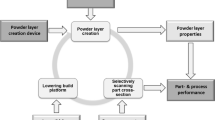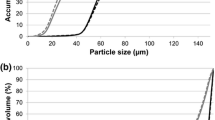The paper discusses the aspects of granulometric and morphological analysis of powders used in the technology of selective laser melting. Studies have been carried out to obtain statistical data concerning the particle size distribution, as well as their integral and differential distribution. The aspects of independent significance in this work had to do with identifying the morphological features of the particles. Experimental studies were carried out using certified and validated equipment. Conclusions were drawn about the specific features of the analyzed powders, and directions for further research were proposed, including the formation of databases of powder materials, which can be of value to process engineers who use additive technologies in practice.



Similar content being viewed by others
References
A. I. Khaimovich, V. G. Smelov, V. V. Kokareva, and A. V. Sotov, “Quality management system for the technologies of selective laser fusion of domestic powder compositions,” Izv. Samarsk. Nauch. Tsentra RAN, 20, No. 6 (86), 33–40 (2018).
A. I. Khaimovich, I. S. Stepanenko, and V. G. Smelov, “Optimization of selective laser melting by evaluation method of multiple quality characteristics,” IOP Conf. Series: Mater. Sci. and Eng. “2017 Inter. Conf. on Aerospace Technology, Communications and Energy Systems, ATCES 2017,” 012067 (2018); DOI: 10.1088/1757-899X/302/1/012067.
T. V. Tarasova, P. A. Podrabinnik, and A. A. Filatova, Particle Size Analysis of Powder Materials for Additive Production [in Russian], Izd. MGTU (STANKIN) (2017).
I. N. Kravchenko, D. T. Abdumuminova, and T. A. Chekha, “Research and development of the process for producing powders of a given particle size for plasma coatings,” in: New Materials, Approaches and Technologies for the Design, Production and Operation of Rocket Space Equipment [in Russian], Izd. MGTU im. Baumana, Moscow (2020), pp. 184–187.
Y. Zhang, J. C. Outeiro, and T. Mabrouki, “On the selection of Johnson-Cook constitutive model parameters for Ti–6Al–4V using three types of numerical models of orthogonal cutting,” Procedia CIRP, 31, 112–117 (2015); DOI: https://doi.org/10.1016/j.procir.2015.03.052.
V. S. Glazunov and M. V. Cherepanova, “The use of additive technologies in the manufacturing of ceramic products,” Vesti Perm. Nats. Issled. Politekh. Univ., No. 4, 174–187 (2018); DOI: https://doi.org/10.15593/2224-9400/2018.4.14.
K. Liu, H. Sun, Y. Tan, Y. Shi, J. Liu, S. Zhang, and S. Huang, “Additive manufacturing of traditional ceramic powder via selective laser sintering with cold isostatic pressing,” Inter. J. Adv. Manuf. Technol., No. 3, 945–952 (2017); DOI: https://doi.org/10.1007/s00170-016-9441-3.
S. N. Perevislov, “Structure, properties, and applications of graphite-like hexagonal boron nitride,” Refractories and Industrial Ceramics, 60, 3, 291–295 (2019); DOI: https://doi.org/10.1007/s11148-019-00355-5.
D. D. Nesmelov, O. A. Kozhevnikov, S. S. Ordan’yan, et al., “Precipitation of the eutectic Al2O3–ZrO2(Y2O3) on the surface of SiC particles,” Glass and Ceramics, 74, No. 1, 43–47 (2017); DOI: https://doi.org/10.1007/s10717-017-9925-0.
M. A. Markov, A. V. Krasikov, A. D. Bykova, et al., “Preparation of MoSi2–SiC–ZrB2 structural ceramics by free sintering,” Refractories and Industrial Ceramics, 60, No. 4, 385–388 (2019); DOI: https://doi.org/10.1007/s11148-019-00372-4.
I. A. Zhukov, P. Y. Nikitin, A. B. Vorozhtsov, et al., “The use of intermetallic AlxMgy powder to obtain AlMgB14-based materials,” Materials Today Communications, 22, 100848 (2020); DOI: https://doi.org/10.1016/j.mtcomm.2019.100848.
X. Li, Modeling and Simulation of Grinding Processes Based on a Virtual Wheel Model and Microscopic Interaction Analysis, Worcester, U. S. (2010).
A. V. Sergeevichev and A. A. Fedyaev, “Statistical multifaceted model of abrasive grain,” Sistemy. Metody. Tekhnologii, No. 3 (31), 99–106 (2016).
A. Domiaty and A. Abdel-Rahman, “Fracture mechanics-based model of abrasive waterjet cutting for brittle materials,” Inter. J. of Advanced Manufacturing Technol., 13, Issue 3, 172–181 (1997).
P. Klapetek, I. Ohlídal, D. Franta, et al., “Atomic force microscopy characterization of ZnTe epitaxial films,” Japanese J. of Applied Physics, 42, No. 7B, 4706–4709 (2003); DOI: https://doi.org/10.1143/JJAP.42.4706.
O. V. Yegorova, Technical Microscopy. Practice of Using Microscopes for Technical Purposes. Being “on First-name Terms” with a Microscope [in Russian], Tekhnosfera, Moscow (2007).
N. N. Gavrilova, V. V. Nazarov, and O. V. Yarovaya, Microscopic Methods for Determining the Size of Dispersed Material Particles [in Russian], Izd. RKhTU im. D. I. Mendeleeva (2012).
H. K. Tönshoff, M. Jung, S. Männel, and W. Rietz, “Using acoustic emission signals for monitoring of production process,” Ultrasonics, 37, 681–686 (2000).
V. A. Naumov, “Dependence of the force of hydrodynamic resistance of solid particles on their aspheric parameter,” Vestnik Nauki i Obrazovaniya Severo-Zapada Rossii, 1, No. 1, 95–104 (2015).
G. Guerrini, A. Fortunato, A. A. Bruzzone, and D. M. Daddona, “Abrasive grains micro geometry: A comparison between two acquisition methods,” Procedia CIRP, No. 67, 302–306 (2018); DOI: https://doi.org/10.1016/j.procir.2017.12.217.
W. Kapłonek and K. Nadolny, “Review of the advanced microscopy techniques used for diagnostics of grinding wheels with ceramic bond,” J. of Machine Eng., 12, No. 4, 81–98 (2012).
S. A. Voronov and W. Ma, “The effect of the abrasive grain geometry on cutting forces during polishing,” Vestnik MGTU im. N. E. Baumana, Ser. Mashinostroyeniye, No. 5, 52–63 (2017).
S. Malkin and C. Guo, Grinding Technology: Theory and Applications of Machining with Abrasives, Industrial Press Publ., New York (2008).
A. A. Barzov and A. L. Galinovsky, Material Ultra Blasting Treatment and Diagnostic Technologies [in Russian], Izd. MGTU im. N. E. Baumana, Moscow (2009).
E. J. Lee, H. J. Hwang, W. G. Lee, K. H. Cho, and H. Jang, “Morphology and toughness of abrasive particles and their effects on the friction and wear of friction materials: A case study with zircon and quartz,” Tribology Letters, 37, No. 3, 637–644 (2010); DOI: https://doi.org/10.1007/s11249-009-9561-0.
Author information
Authors and Affiliations
Corresponding author
Additional information
Translated from Metallurg, Vol. 66, No. 6, pp. 68–74, June, 2022. Russian DOI: https://doi.org/10.52351/00260827_2022_06_68.
Rights and permissions
Springer Nature or its licensor holds exclusive rights to this article under a publishing agreement with the author(s) or other rightsholder(s); author self-archiving of the accepted manuscript version of this article is solely governed by the terms of such publishing agreement and applicable law.
About this article
Cite this article
Galinovsky, A.L., Kravchenko, I.N., Martysyuk, D.A. et al. Granulometric Analysis of Powder Materials Used for Producing Samples by Method of Selective Laser Melting. Metallurgist 66, 688–697 (2022). https://doi.org/10.1007/s11015-022-01377-0
Received:
Revised:
Accepted:
Published:
Issue Date:
DOI: https://doi.org/10.1007/s11015-022-01377-0




